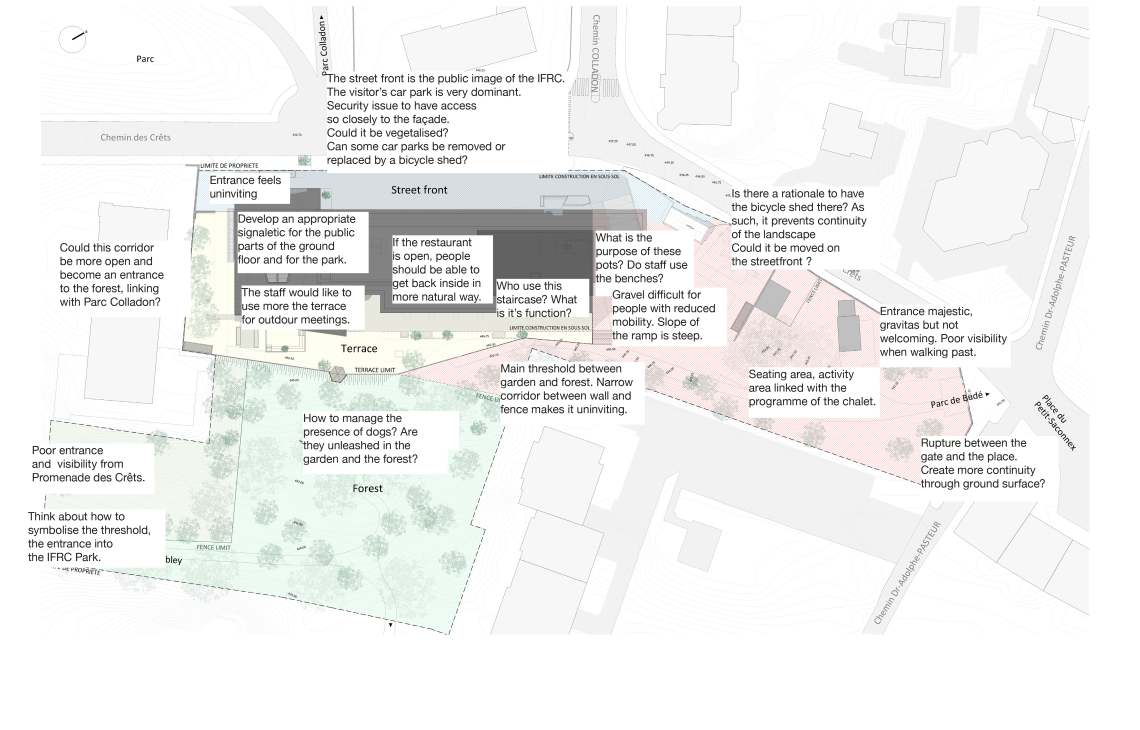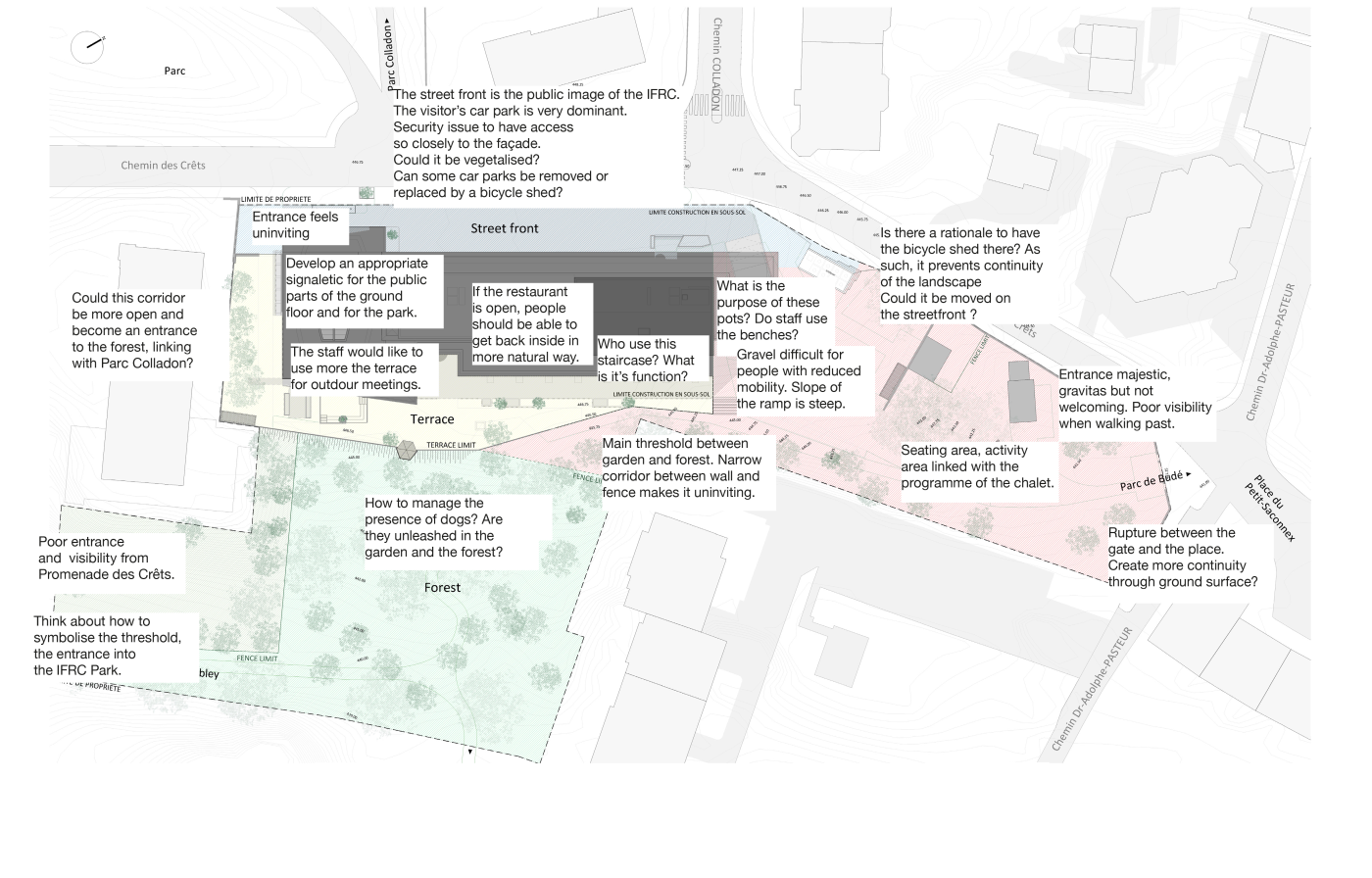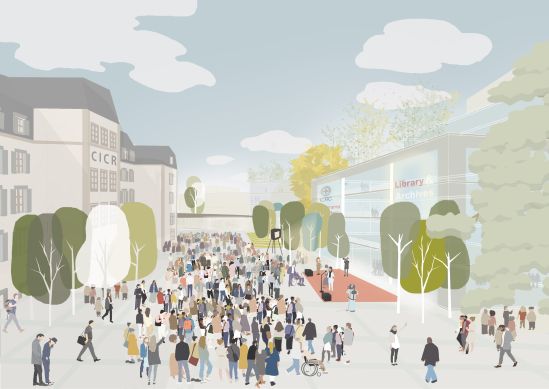User-Choices - Themes for the Red Cross Park, Geneva
User-Choices - Themes for the Red Cross Park, Geneva
The International Federation of Red Cross (IFRC) is located in Petit Saconnex, the international neighbourhood in Geneva, which is home to several other international organisations. Unlike other organisations though, that are predominantly surrounded by offices and embassies, the IFRC is located near a residential area and is peppered with community organisations, churches, and mosques in the vicinity of the Palace du Petit Saconnex (neighbourhood square).
The IFRC headquarters is housed in a single building. The rest of its campus can be broadly divided into a garden, a concrete street front facing the Chemin des Crêst, a terrace connected to the indoor restaurant that is open to locals, and the urban forest that sits next to one of Geneva's ecological corridors.
Due to participants' awareness of the site's existing context, their thoughts during the participatory process were spontaneously based on pre-existing elements, listed below:
The Forest
The participants described it as an important cool place that protects them against the city's constantly growing urban heat island effect. It was described as a calm oasis where one felt at a distance from urban bustle, while being surrounded by the city. The residents proposed adding clearer pathways designed for people with reduced mobility. They also proposed that there should be benches or places to sit in the forest which should be open at night with adequate lighting.
Most IFRC members referred to the forest as a 'secret forest' because they did not know about it. They conveyed that the forest looks like private land or a cul de sac, and the path to it from the square is not clear. Hence, the proposed landscaping plan must address the continuity issue with current paths and streets.
Furthermore, the role of water in the future landscaping project was central to the discussions. Residents who have lived in the neighbourhood for a long time remembered a little rivulet flowing through the forest, the riverbed of which is still visible.The urbz team had more conversations with locals about the rivulet and the possibility of reintroducing it to the forests. Questions like "Where did the water originate from?" and "Could the tiny pond welcome the rain waters from the IFRC rooftop and building?" drove the conversation.
Terrace and Cafeteria
Some elderly people remember going to the IFRC cafeteria before the Covid lockdown and miss such an opportunity to mix with international Geneva residents from the neighbourhood. However, most interviewees did not know that the cafeteria was open to the public and identified a lack of signage as the main issue. Some residents expressed that a simple board such as "cafeteria is open" on the street could help people feel more welcome in this space.
People love the little pavilion on the side of the terrace because it is a remnant from the old house and gives the space an exceptional quality. This element could be more valorised in opening up the terrasse to Square Park and the urban forest.
Garden connecting the village square
The garden also has the potential of being a space with a more social and cultural atmosphere, complementary to the wilder identity of the forest. The chalet, (presently a large, cosy shed) is already an activated place, with a convention linking the IFRC and a local neighbourhood residents association for temporary use for 3 years. Its activities could connect the IFRC ground to the neighbourhood in meaningful ways. The existing exclusive use of the chalet by the association and an artist's collective creates some dissatisfaction in the neighbourhood, as residents feel larger activities of the community should be included.
Streetfront and entrance.
The street front has a strong presence of concrete, asphalt and other non-organic elements. It lacks green spaces, and many interviewees shared that it does not reflect the welcoming and open attitude of the organisation. This feeling can be traced back to different reasons. For some, the existing car park feels very dominant. It has been suggested to reduce the number of above-ground parking spaces to create more green spaces. The IFRC building also houses an intercultural library on the ground floor that can be accessed from the street front entrance. However, it was pointed out that, presently, the lack of signages makes it invisible.
The streetfront is also where a new Ecopoint (a waste segregation area) has been developed, leading to some concerns. In the past, the street front had a continuous wall that was once part of the old building that housed the IFRC. People from the neighbourhood were attached to it as a valuable remnant of the past. Unfortunately, a part of it was brought down to build the Ecopoint, which was perceived as unnecessary and even a bit disrespectful to local heritage .
Potential test interventions
As the participatory process unfolded, the participants proposed a few quick-to-implement interventions based on the above findings to move the project forward proactively. These include creating appropriate signages regarding the cafeteria's accessibility and IFRC initiatives including access to the library and an Open-Doors Day to open the IFRC premises to public visitors. They also suggested opening the fence between the square park, cafeteria, and forest and creating seating areas in the forest.
The discussions through these participatory processes are being translated into a shared vision and value proposition that will guide the new plan for the IFRC park.



